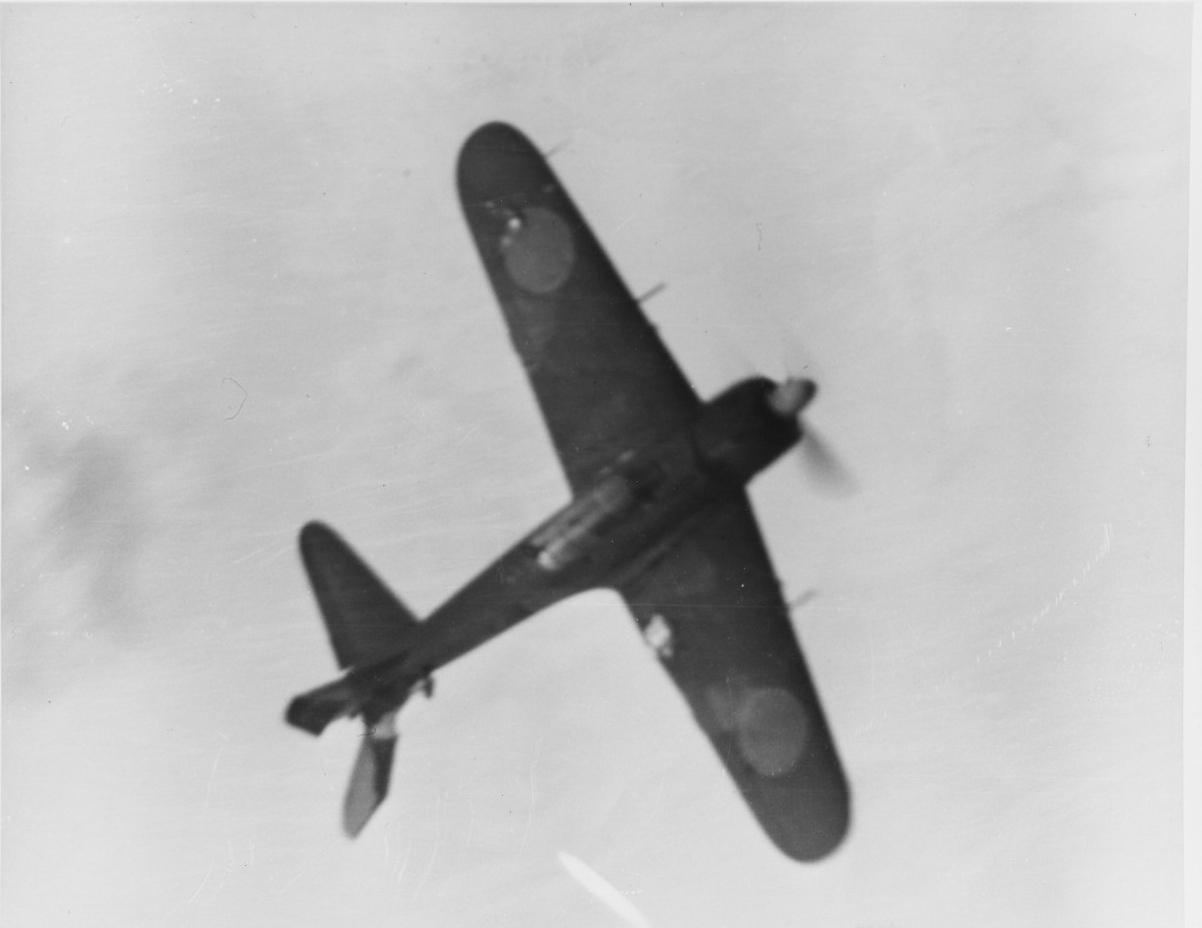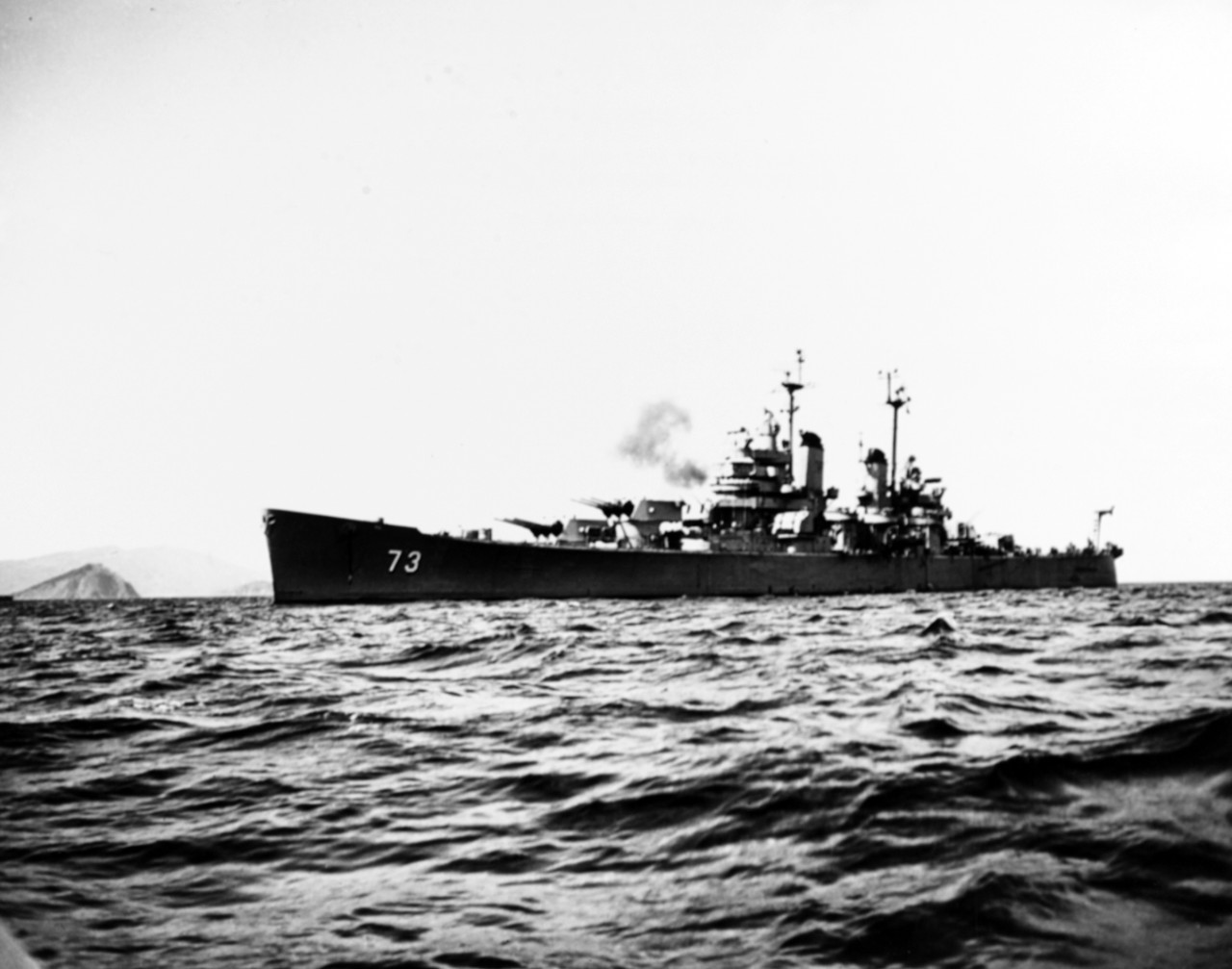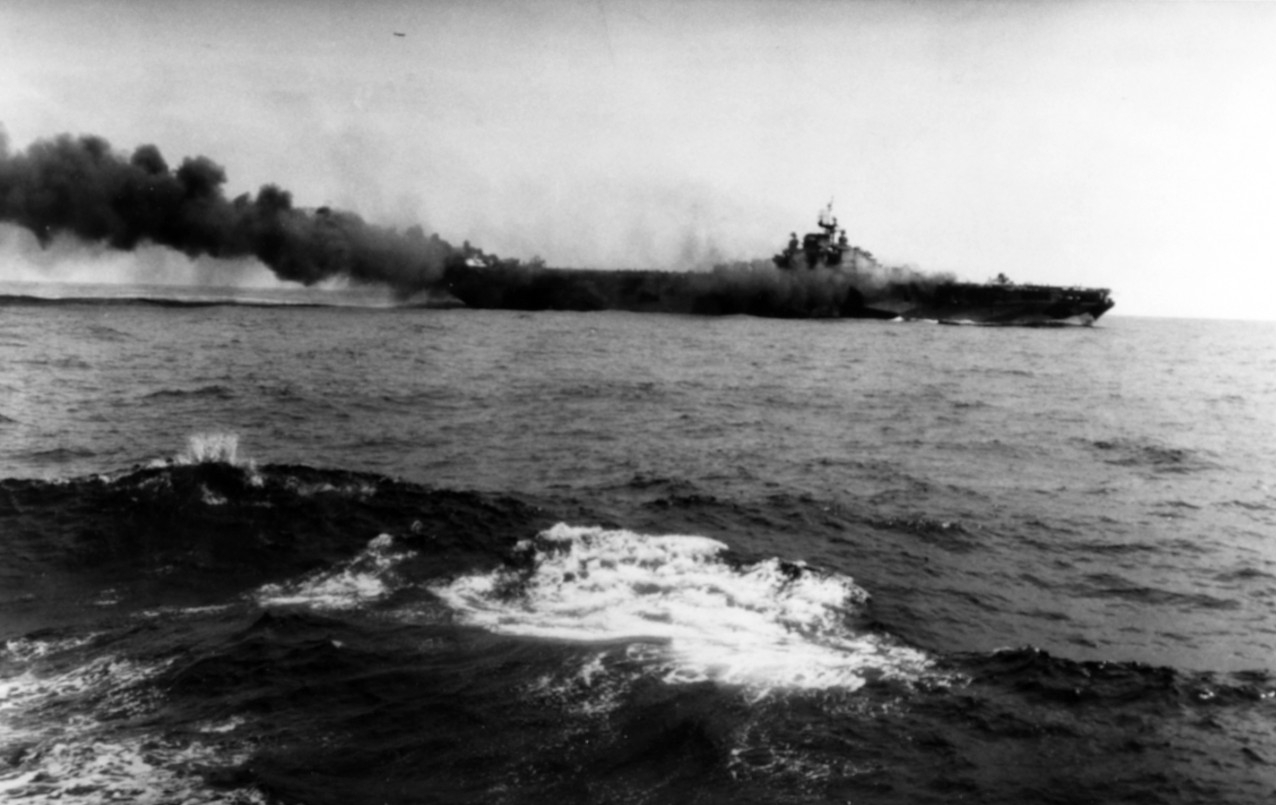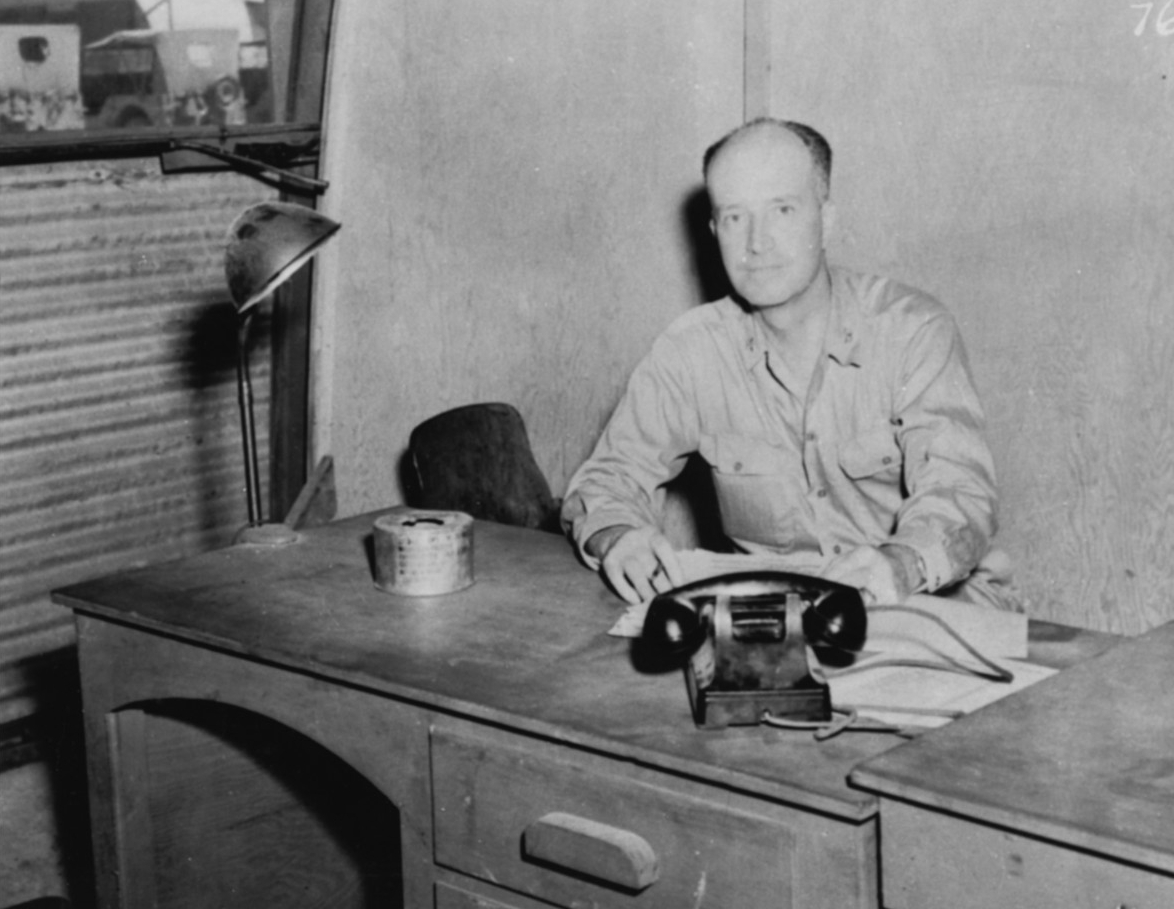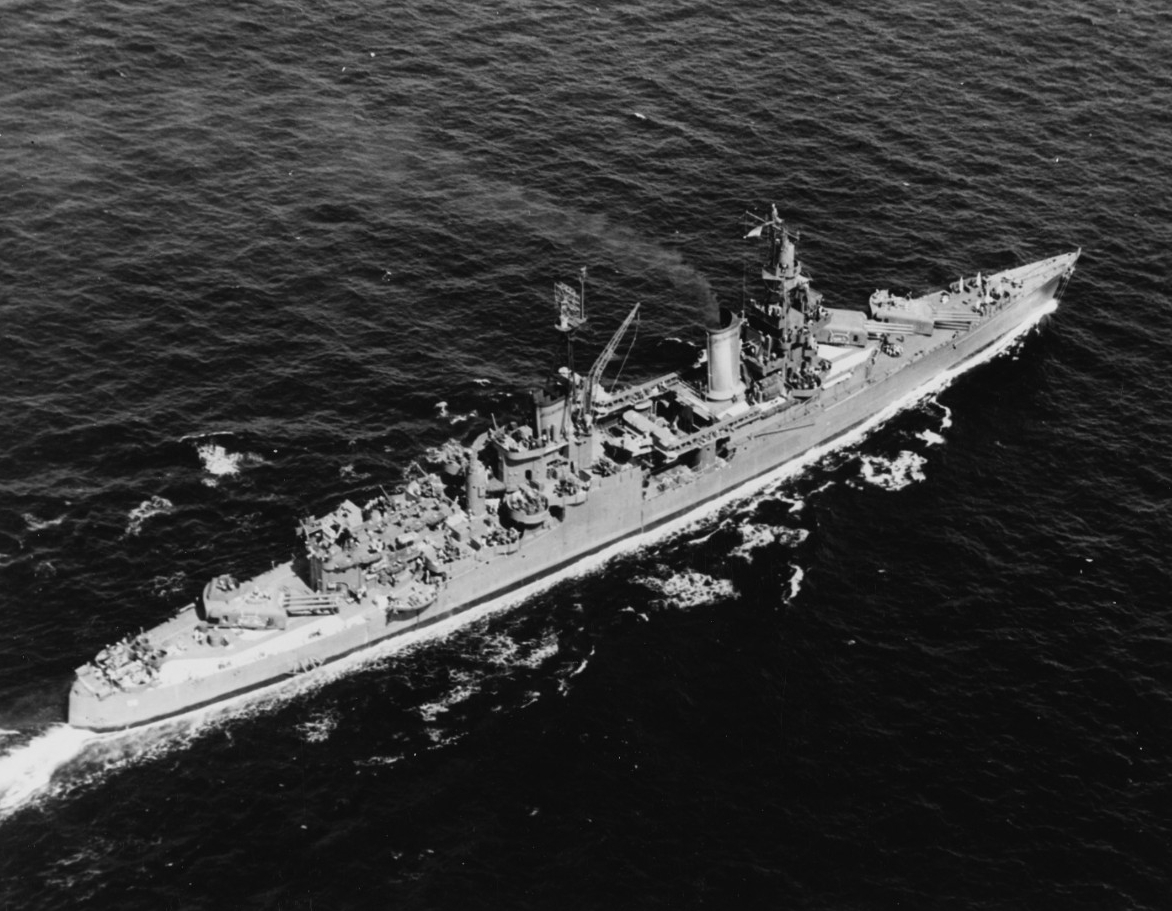H-Gram 079: Kamikazes, Atomic Bombs, and USS Indianapolis (CA-35)—and a Little on the Korean War
24 July 2023
Download a PDF of H-Gram 079 (2.6 MB).
This H-gram covers the publication of an NHHC study on the impact and psychological effects of the Japanese kamikaze attacks off Okinawa on U.S. Navy sailors in April–June 1945 (“On the Verge of Breaking Down Completely”: Surviving the Kamikaze off Okinawa 1945 by NHHC historian Guy Nasuti). These attacks also had a major effect on senior U.S. political and military leaders and were a significant factor in the decision to use the atomic bomb. With the opening of the movie Oppenheimer, I am reprising my H-Gram 052, which discusses the major role of the U.S. Navy in the development and use of the atomic bombs. The heavy cruiser USS Indianapolis (CA-35) delivered critical components of the first atomic bomb prior to being sunk by Japanese submarine I-58. I include my recent remarks at a ceremony honoring the last living survivor of Indianapolis, Harold Bray.
70th Anniversary of the Korean War: The Last Shot
At 2129 on 27 July 1953, the heavy cruiser USS Saint Paul (CA-73) fired an 8-inch shell timed to impact on an enemy gun position near Wonsan, North Korea, seconds before the armistice went into effect at 2200. This was the last shot by U.S. naval forces during the Korean War and the shell was autographed by Rear Admiral Harry Sanders, commander of Cruiser Division ONE. Saint Paul had been hit by enemy shore battery fire in the same area on 11 July, although damage was minor and there were no dead or wounded. Of note, Saint Paul also fired the last World War II shot by a major U.S. warship on 9 August 1945 during a bombardment of the Kamaishi Iron Works on Honshu. Sanders was awarded his sixth Legion of Merit with Combat “V” while in command of the cruiser force off Korea (his first five awards were from World War II).
I had hoped to have a Korean War wrapup done by this time to coincide with the armistice and ceasefire, but I have fallen way behind in H-gram writing. However, it is on the way. The last two years of the war proved to be the most dangerous for the U.S. Navy, particularly naval aviation, as North Korean and Chinese air defenses and shore defenses continued to improve despite constant air and surface bombardment.
80th Anniversary of World War II: “On the Verge of Breaking Down Completely”
China’s People’s Liberation Army Navy (PLA[N]) studies World War II Pacific operations, particularly the Guadalcanal campaign, to gain insight into battles in which two roughly evenly matched foes duke it out in bloody battles that could go either way—as they see themselves increasingly in an even match with the U.S. Navy. Although the Chinese are not likely to resort to “kamikaze” deliberate suicide attacks, the U.S. Marines at Chosin Reservoir experienced the relentless Chinese “human wave” assaults, during which the Chinese demonstrated a willingness to incur massive casualties in order to achieve their objective. So, the question may be asked, in a potential future war with China in which the Chinese demonstrate a willingness to incur great losses, what is the ability of the U.S. Navy and our crews to absorb high casualties and still keep fighting, particularly since we haven’t taken a serious hit from an enemy since 2000? In order to address such a question, I had our historians conduct a case study in which the U.S. Navy suffered high casualties (4,900 killed) against a determined and capable enemy (willing to take high casualties) in a situation where the U.S. Navy had to stand and fight against a land-based air force, as well as submarines and other threats. The result was “On the Verge of Breaking Down Completely” by NHHC Historian Guy Nasuti.
This study offers a compelling new account of how U.S. sailors dealt with their most destructive enemy—the kamikazes of the Imperial Japanese Special Attack Corps. Beyond just examining the tactics and damage control efforts U.S. Navy crews employed to counter the onslaught, Guy provides a compelling and emotional portrayal of the sailors’ experiences, highlighting how they battled through near-constant fatigue and grief to ensure their own survival. With a foreword by ninth MCPON James L. Herdt (whose own father endured kamikaze attacks on board Mississippi [BB-41]), Guy’s publication and its depictions of “warrior toughness” in action are sure to resonate with our sailors and the general public.
I would be delighted if this study were to receive broad distribution throughout the Fleet, as part of a process of getting mentally ready for potential conflict. Although it is great to learn from your mistakes, it is even better to learn from the mistakes of others. The U.S. Navy suffered from an acute case of overconfidence regarding the Japanese threat prior to World War II—an overconfidence that was culturally ingrained and quite unjustified. Having been essentially unchallenged for almost 80 years, it may still exist in the U.S. Navy today regarding the Chinese.
A historic something to think about: The fleet was overworked, the ships were under-manned, and the sailors were fatigued. Many of the ships were old and worn out. There was a backlog of deferred maintenance and a critical shortage of spare parts. There was an acute shortage of ammunition (much of what was available was defective, although this was not known). Weapons were not keeping pace with the threat, and with minimal live-fire training (due to cost and shortage of weapons), many were defective (particularly torpedoes). Even with under-manned ships, the training pipeline was not meeting requirements, and much training was unrealistic. The fleet was burdened with excessive administrative requirements. There were major problems and delays in shipyards. The service was training for the war it expected to fight and wanted to fight, not the one that the enemy planned. And yet, through all this, the navy in question was quite confident it could beat the enemy quickly. The navy? The U.S. Navy. The year? 1941.
This is documented in great detail in the memoir of Admiral James O. Richardson, On the Treadmill to Pearl Harbor. Richardson was Commander-in-Chief of the U.S. Fleet (CINCUS), which included all operational forces in the Atlantic and Pacific. He was also the U.S. Navy’s foremost flag-level expert in the Japanese way of war, having made a lifetime study of the Japanese. He believed that moving the Battle Fleet (the Pacific Fleet) to Pearl Harbor in 1940 was logistically unsound, and rather than a deterrent to the Japanese was a provocation that invited attack (and that Pearl Harbor was indefensible against air attack ). He was outspoken with President Roosevelt regarding the status of the fleet and Pearl Harbor. As a result, he was fired. Richardson’s relief in February 1941 was Admiral Husband Kimmel, who would pay the price for the fact that Richardson had been correct.
80th Anniversary of World War II: The U.S. Navy and the Atomic Bomb
The movie Oppenheimer opened this weekend. I haven’t seen it yet, but by critical accounts it is good and is attracting large audiences. I have no idea how accurately the movie portrays the U.S. Navy’s role in the development of the atomic bomb (since the producers did not ask for support from us). So, I thought this would be an opportune time to republish my previous H-gram sections on this subject.
Inscribed on the “Little Boy” atomic bomb dropped on Hiroshima on 6 August 1945 was a message to Japanese Emperor Hirohito “From the boys of Indianapolis,” a reference to the 880 crewmen who were lost in the sinking of the heavy cruiser Indianapolis after she delivered critical components of the bomb to the B-29 bomber base on Tinian Island. On the receiving end of the bomb were family members of the skipper of I-58, the Japanese submarine that sank the cruiser. There were also a dozen U.S. prisoners of war, 20,000 Japanese military personnel, and between 70,000 and 126,000 Japanese civilians who were vaporized or incinerated by the blast, or died of grievous wounds or radiation sickness in the next couple months, and many others would die from the effects of radiation long afterward.
Although it is well known that the first atomic bomb was dropped by the B-29 Enola Gay piloted by Colonel Paul Tibbets, it is much less well known that the mission commander on the Enola Gay was U.S. Navy Captain William S. “Deak” Parsons, who was also the director of Project Alberta, the weaponization of atomic energy within the overarching Manhattan Project. Dr. J. Robert Oppenheimer would later state, “It is impossible to overestimate the value which Captain Parsons has been to the project.”
The mission commander on the B-29 Bock’s Car that dropped “Fat Man” (the second atomic bomb) on Nagasaki was Parson’s operations officer, Commander Frederick L. “Dick” Ashworth, USN. The head of the “Little Boy” assembly team was Commander Francis Birch, USNR, and the head of the “Fat Man” assembly team was Commander Norris Bradbury, USNR. By 1945, there were 41 U.S. Navy officers working at the Manhattan Project laboratory at Los Alamos under the direction of Oppenheimer and his deputy, Captain Parsons. While the eminent physicists and scientists worked through the extraordinary challenges of creating a nuclear chain reaction, the military officers and engineers under Captain Parsons worked the equally important challenges of turning it into a bomb that worked and developing an aircraft that could deliver it. (In addition to his role in the Manhattan project, Parsons was previously the leader in the development of the radar proximity fuse, which revolutionized U.S. surface ship anti-aircraft defenses in the latter half of World War II.) Another Navy officer who played a key role was Rear Admiral William R. Purnell, who was the Navy representative on the three-man committee that provided oversight of the Manhattan Project.
The Navy’s research into atomic energy began with the lecture on 18 March 1939 in Washington, DC, by Italian refugee and eminent physicist Enrico Fermi, who described the process of nuclear fission that had been discovered only a few months earlier in Germany. The news had originally been relayed by Austrian-born refugee scientists living in Sweden and Denmark. Attending Fermi’s brief was the technical director of the Naval Research Laboratory (NRL), Ross Gunn, who immediately recognized the potential of atomic energy for submarine propulsion. The Navy’s research into atomic energy commenced shortly after, seven months before the start of the U.S. Army’s project (although the Navy was focused on propulsion and the Army on weapons). The Manhattan Project subsequently dwarfed the NRL effort as the former had virtually unlimited funding and first priority on scarce resources, such as uranium and plutonium. Nevertheless, NRL civilian physicist Dr. Philip Abelson developed a process to separate fissile isotope Uranium-235 from the more common U-238 (“liquid thermal diffusion isotope separation”), which the Manhattan project eventually incorporated and which shaved off precious time in the race to beat Nazi Germany to the bomb and then to hopefully head off what was expected to be an incredibly bloody invasion of Japan.
There is no question that the atomic bomb was a terrible weapon and the entire world should be exceedingly grateful that it has never been used again. It was also a terrible weapon that ended a terrible war, which by then had resulted in the deaths of more than 60 million people. President Truman and senior U.S. military leaders were faced with difficult choices to end the war in the Pacific, all of them awful. They chose the option that killed the fewest Americans. It also killed far fewer Japanese than an invasion or continued fire-bombing, blockade, and starvation would have. The idea that there was a more humane way to end that vicious war constitutes wishful thinking.
For more on the U.S. Navy and the atomic bomb please see H-Gram 052 for an overview and attachment H-052-1: The U.S. Navy and the Atomic Bomb for detailed coverage.
USS Indianapolis (CA-35): The Last Survivor
A USS Indianapolis reunion was held 6–9 July in Benicia, California, the hometown of Harold Bray, the last living survivor of the ship’s final crew. The theme of the reunion (which now obviously is mostly family and friends) was “The Last Liberty—Honoring Her Final Sailing Crew.” Indianapolis received her sailing orders on 15 July 1945 and departed Mare Island the same day, stopping briefly at Hunter’s Point, San Francisco, to embark components of the first atomic bomb. During the weeks prior to her sailing, the ship had been undergoing repair at Mare Island from a kamikaze hit off Okinawa, so the “last liberty” for her crew would have been in the Mare Island/Vallejo/Benicia and San Francisco areas. In the end, 316 of her crew survived and 880 were lost.
The Benicia Community Foundation, along with a long list of other benefactors, commissioned a statue in honor of Benicia’s hometown hero, Harold Bray. It was unveiled on 7 July in Benicia to an outdoor ceremony with a crowd of at least 1,000, and included a proclamation by Benicia Mayor Steve Young along with a 21-gun rifle salute and “Taps.”
You will find my remarks at the occasion here.
As always, you are welcome and encouraged to disseminate H-grams widely. Previous H-grams may be found here.

